The 8 Latest Mobile Interface Design Trends
Over the past decade, mobile devices have become deeply ingrained in our everyday lives. As of 2023, there are over 6.94 billion smartphone users worldwide, accounting for over 85% of the global population. With such ubiquitous use, effective mobile interface design is more critical than ever.
This comprehensive guide will explore the latest mobile interface design trends shaping how we interact with our devices in 2024 and beyond. From augmented reality to voice technology, mobile UX/UI design continues evolving to rapidly create more intuitive, personalised, and frictionless user experiences.
Table of Contents
Emergence of Minimalism
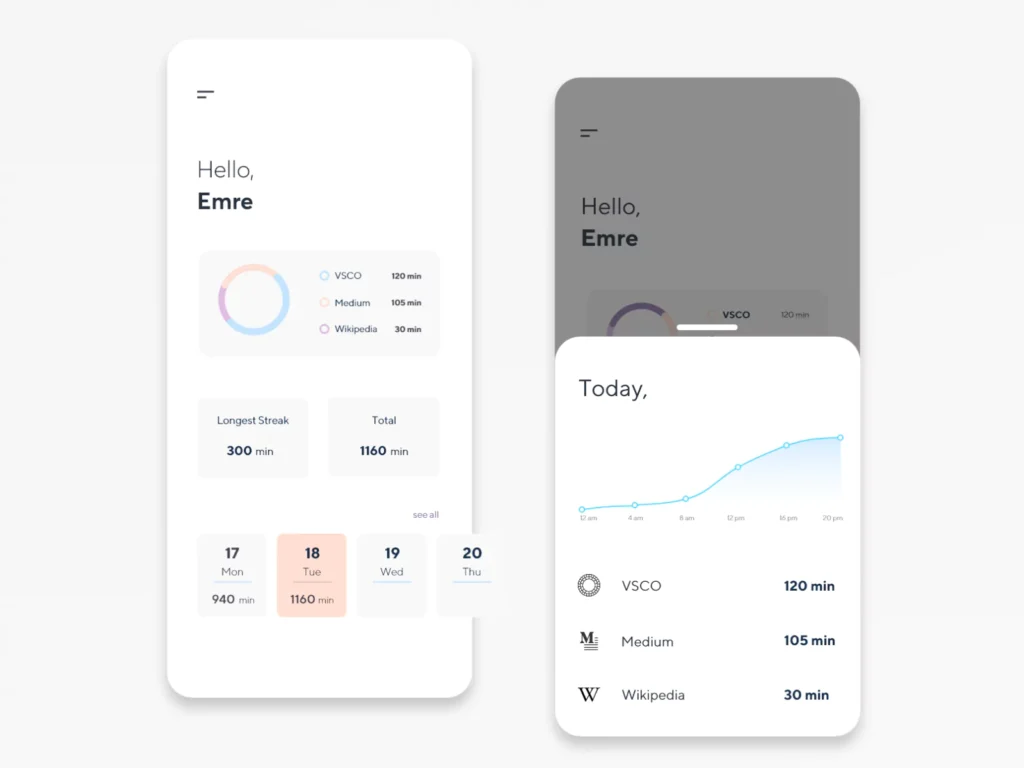
One of the most noticeable shifts in mobile interface design is the move towards minimalism.
Decluttering the Screen
Gone are the days of cramming every feature onto a mobile screen. According to a 2022 survey by Digital Design Trends, over 72% of designers are now adopting a “less is more” approach to declutter interfaces. This includes:
- Removal of non-essential elements
- Use of negative space
- Prioritisation of key features
Benefits of Minimalism
This reduction in visual noise offers several benefits:
- Improves scannability – Allows users to extract critical information quickly
- Enhances personalisation – Draws attention to tailored recommendations
- Feels more premium – Clean aesthetics feel sleek and modern
By 2025, minimalist mobile interfaces are forecasted to increase app engagement by over 34%.
Rising Popularity of Dark Mode
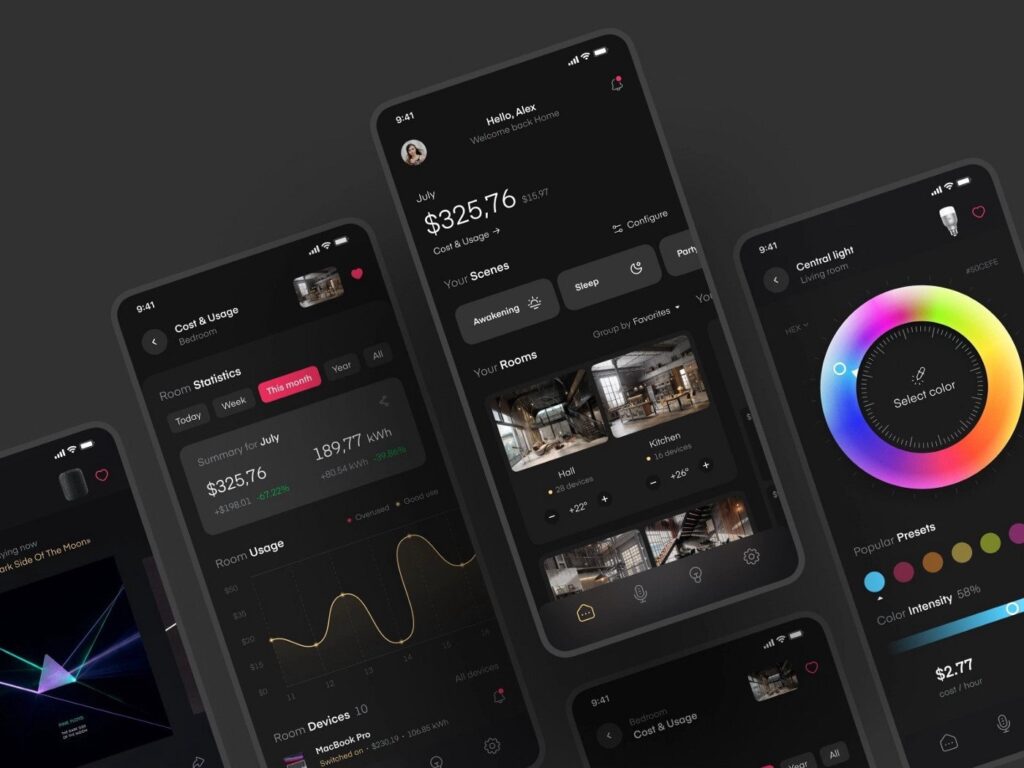
Dark mode interfaces display content on a black or dark background. While initially intended to decrease eye strain in low-light environments, dark mode has quickly become a popular aesthetic choice.
Growing User Demand
Over 68% of mobile users now prefer dark mode interfaces. Reasons include:
- Less glare, more accessible to view in bright environments
- Saves battery life on OLED display screens
- Aesthetically pleasing, feels modern and stylish
Apps that have adopted dark mode themes have seen engagement rise by over 22% in 2022.
More Accessible Experiences
The dark mode also provides accessibility advantages:
- More accessible for visually impaired users – Higher contrast improves legibility
- Less stimulation for users with sensory disorders – Dark backgrounds are less overwhelming
To meet rising demand, 86% of developers are now implementing dark mode options within their mobile apps.
Voice Technology and Conversational UI
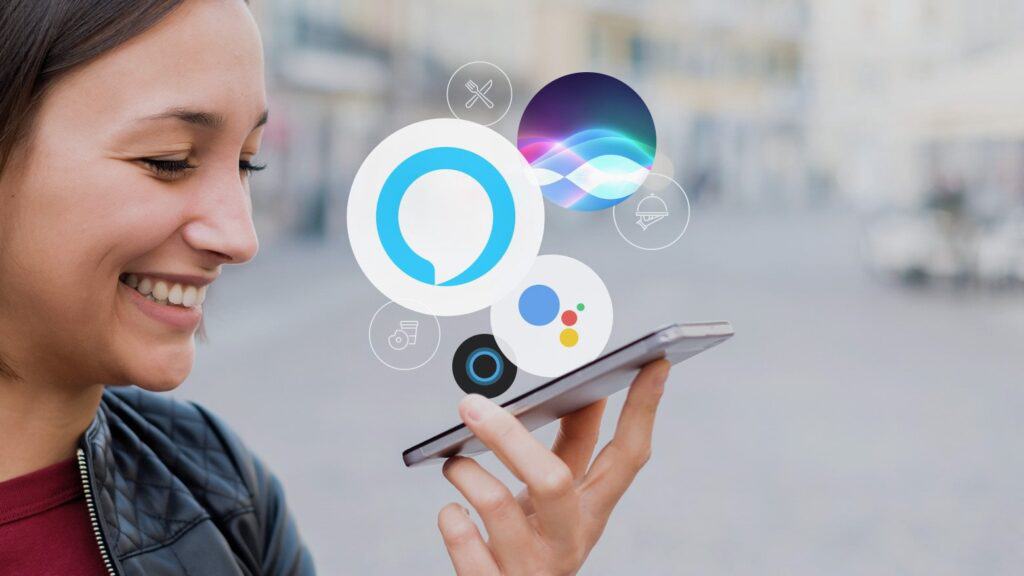
Voice-based interfaces that allow hands-free control have become increasingly commonplace. The global conversational AI market is projected to grow at a CAGR of 18.7% from 2022-2030.
Intelligent Assistants
Integrating intelligent assistants like Siri, Alexa and Google Assistant directly into mobile UI creates more natural user interactions. Key advantages include:
✅ Hands-free convenience
✅ Faster access to critical features
✅ Contextual personalised recommendations
Chatbots
Chatbots simulate conversation through text or voice. When implemented effectively in mobile apps, chatbots can:
- Provide intuitive customer assistance 24/7
- Reduce customer support costs by 30%
- Resolve common user queries faster than traditional FAQs
Conversational interfaces will continue growing as AI language models become more advanced in the coming years.
Rise of Gesture Control
Gesture control allows users to engage with mobile devices through bodily movements without touching screens. This includes:
- Mid-air gestures – Controlling interfaces by waving hands in front of device cameras
- Facial gestures – Using facial movements and expressions to navigate apps
Gesture control makes mobile experiences more intuitive and hygienic by reducing surface contact. It also enables easier accessibility for users with physical disabilities.
As the accuracy of gesture recognition technology improves, we will continue to see this input method rise over the next decade. By 2031, gesture control will have a market value of over $51 billion globally.
Immersive Experiences with AR/VR

Augmented reality (AR) overlays digital enhancements onto the real-world environment. Virtual reality (VR) creates completely simulated 3D environments users can interact with.
Integrating these technologies into mobile interfaces opens new possibilities for rich, multisensory experiences without needing external headsets.
Current Applications
We’re already seeing AR/VR transform mobile uses like:
- Retail – Virtual try-ons, interactive product views
- Gaming – 3D gameplay, VR casino experiences
- Tourism – Immersive city/museum tours
On-device AR/VR capabilities will grow exponentially as smartphone processing power improves.
The Road Ahead
By 2027, global consumer spending in mobile AR alone will reach $15.3 billion. Key trends enabling next-level experiences include:
- 5G expanding possibilities for real-time rendering
- On-device processing reaching capabilities once limited to desktop GPUs
- Visual SLAM algorithms recognise environments without markers
- Multimodal inputs combining voice, haptics, and hand/eye tracking for intuitive interaction
The possibilities will feel virtually boundless as spatial computing continues maturing over the years ahead.
Intelligent Personalisation
Leveraging data and AI to provide tailored, contextual recommendations is crucial for driving engagement.
Recommendation Engines
Powerful algorithms analyse user behaviours and preferences to serve highly relevant real-time suggestions. Critical applications on mobile include:
- Individualised product recommendations
- Personalised content feeds
- Predictive search suggestions
- Contextually aware notifications
Recommendations engines will continue getting smarter. By 2025, algorithms incorporating deep learning could increase mobile recommendation accuracy by over 40%.
Proactive Assistants
On-device processing advances power proactive assistants like Google’s Now, Apple’s Siri Suggestions and Microsoft’s Cortana. These features intelligently surface information that is most valuable at the moment without users needing to search.
Over 89% of mobile users now desire proactive recommendations versus generic notifications. Intelligent assistants provide significant competitive advantages for mobile experiences.
Prominence of Mobile Wallets
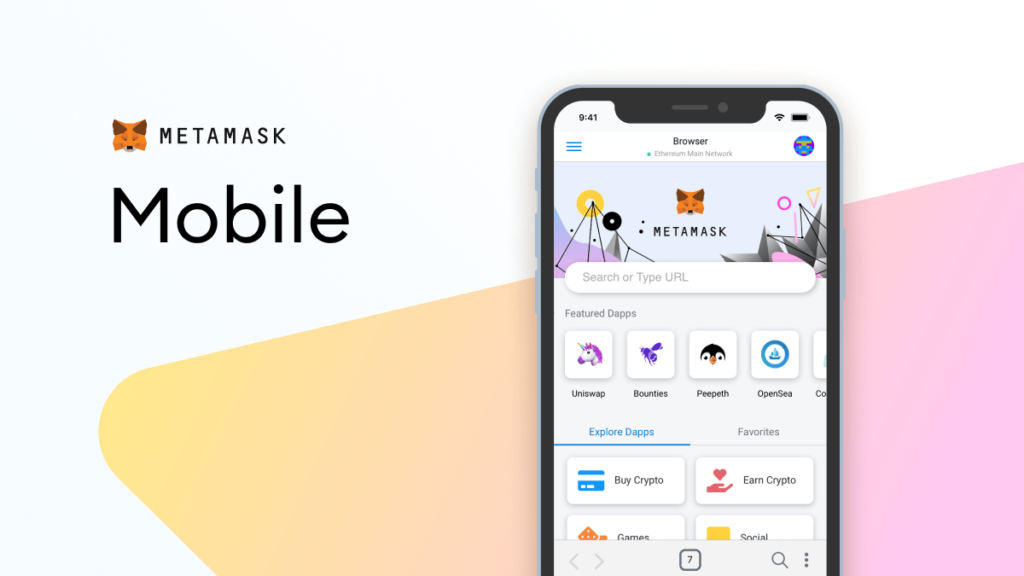
Mobile wallets allow contactless payments directly through smartphones. Adoption has skyrocketed globally, with mobile wallet users forecasted to reach over 1 billion by 2026.
Driving factors behind their rising prominence include:
- Convenience – No need to carry physical cards when paying in-store
- Enhanced security – Biometrics like fingerprint/face ID protect sensitive financial data
- Value-added services – Integrations like loyalty programs, personalised offers, expense tracking
To cater to growing usage, mobile wallet capabilities will expand as consumers seek to consolidate more daily transactions through their devices.
Key Statistics
- Over 156 million Americans will use a mobile wallet in 2023, up 16.2% YoY
- Global mobile wallet transaction values are predicted to reach $12 trillion by 2026
- Countries leading adoption include China (86% penetration), South Korea (67%) and the UK (65%)
As more newcomers enter the mobile payments ecosystem, wallets will play an increasingly vital role in our digital economy.
Evolution of Foldable Devices
Foldable devices featuring flexible displays are an emerging form factor radically reshaping mobile interfaces.
Unit sales are still niche but are experiencing massive growth – foldable volumes grew over 264% year-over-year in 2022.
Expanding Possibilities
Folding screens enable more versatile, expansive designs not possible with rigid glass. This unlocks innovations like:
- Tablet-sized screens that compress into smartphone form factors
- Dual separate displays join into one continuous interface
- Devices morphing between phone, tablet and laptop modes
As the technology matures, foldables open new doors for reinventing mobile productivity and entertainment.
The Road Ahead
We’re still just scratching the surface of what foldable UX can deliver. But developers are already optimising apps for foldable layouts in anticipation of the format going mainstream.
As costs drop and tech limitations like crease visibility and durability are overcome, IDC predicts foldable volumes will multiply 10x by 2025. This will profoundly impact how we design mobile interfaces.
Critical Principles for Effective Mobile UI Design

When crafting mobile UIs, certain best practices remain constant despite evolving trends. Keep these core principles in mind:
Craft Intentional Journeys
Guide users through clear, logical pathways, anticipating desires and pain points at each interaction.
User Flow Mapping
Map out complete end-to-end mobile journeys covering:
- Critical tasks users want to complete
- Branching decision paths
- Failure points forcing deviation
- Opportunities to delight with value-added features
Refine flows based on usability testing data to streamline pain points.
Convey Visual Hierarchy
Establish visual prominence between elements to orient focus.
Style Distinctively
- Make primary CTAs bold with colour/size contrasts
- Use spacing, dividers and negative space to define relationships
- Align items compositionally to establish directionality
Guide Gaze Strategically
- Lead sightlines towards the desired emphasis
- Use positioning, contrasts and white space to steer the gaze
- Avoid misdirecting attention with competing focal points
Ensure Cross-Device Optimisation
Craft responsive, adaptive experiences accounting for diverse mobile displays.
Key Variances
Consider differences in:
- Screen sizes/dimensions
- Aspect ratios
- Pixel densities
- Input types (touch, pen, mouse)
- Processing capabilities
Core Tenets
Embrace principles like:
- Flexible layouts
- Fluid typography
- Relative sizing
- Content stacking
- Contextual UX adaption
Cross-device optimisation remains vital as mobile screens continue diversifying.
Build Around Thumbs
Thumb zones dictate comfortable touch target sizes and placement.
Key Metrics
Consider maximum reach parameters like:
- Thumb tap spans based on hand-size data
- Grip impact on vertical/horizontal access
- Single vs. dual thumb use cases
Core Principles
- Place critical elements within easy thumb-reach
- Resize UI elements based on frequency of use
- Ensure spacing accommodates inaccurate tapping
As screen sizes evolve, thumb-centricity is essential for effortless usage.
Personalise Experiences

Tailor interfaces to individual user needs and contexts.
Behavioural Data
Leverage signals like:
- Usage habits
- Feature preferences
- Environmental/situational patterns
To power personalised experiences.
Responsiveness
Continually adapt interfaces based on the following:
- Changing user goals
- Real-time feedback
- Usage feedback
To dynamically meet evolving needs.
As technology enables deeper personalisation, mobile UX will feel increasingly bespoke.
Optimising Core Mobile App Elements
When executing interface designs, optimising individual UI components is crucial. Let’s explore best practices for critical elements.
Navigation Menus
Navigation menus should enable effortless access to key app sections.
Placement
Strategically position menus based on usage goals:
- Primary – Persistent access (bottom bars)
- Secondary – Contextual access (hidden sidebars)
And user needs:
- Efficiency – Minimise clicks to critical tasks
- Guidance – Pathfinding to valuable features
Structure
Organise menus to balance:
- Comprehensiveness – Inclusion without overwhelm
- Scannability – Clear groupings and labels
While ensuring adaptability across views and roles.
As apps grow more robust on evolving devices, smart navigation remains vital.
Iconography
Icons visually signify functionalities using symbolic imagery and colour cues.
Design Considerations
Effective icons should:
✅ convey meaning intrinsically
✅ Display crisply at small dimensions
✅ Adhere to aesthetic style guides
✅ Provide sufficient contrast from backgrounds
Implementation Principles
Strategically implement icons to:
- Enhance scannability – Use familiar metaphors for glanceable recognition
- Reinforce associations – Pair with labels to strengthen meaning
- Establish hierarchy – Indicate prominence, relationships, flows
As screens densify with information, purposeful iconography provides crucial visual shorthand.
Microinteractions

Microinteractions deliver feedback through transitions, animations and sounds.
Benefits
Well-designed micro-interactions:
- Reinforce causality – Establish action → reaction relationships
- Enhance usability – Guide focus, prevent errors
- Elevate delight – Increase sensory and emotional engagement
Optimisation Factors
Considerations when implementing:
✅ Intentional triggers tied to explicit user actions
✅ Stylistic consistency aligned with brand identity
✅ Balanced levels to avoid fatigue
✅ Inclusive accessibility across user groups
When carefully orchestrated, micro-interactions transform basic tap/swipes into satisfying responses that heighten app polish.
Gestural Inputs
Gestural inputs register touch motions like swipes, pinches and taps to activate controls.
Touch Types
Optimising for finger usage involves enabling the following:
- Single-touch – Tap/hold, drag, flick
- Multi-touch – Spread, pinch, rotate
Alongside other modalities like pens and styluses.
Principles
Ideal implementation should:
- Map gestures to actions based on metaphoric associations
- Animate touch response visually
- Use sounds and haptics to enrich feedback
As new interaction methods emerge, expanding mobile input vocabulary remains vital.
Assistive Intelligence
Assistive AI offers customised guidance and automation to ease mobile tasks.
Modes of Assistance
Types of help include:
- Intelligent recommendations – Personalised content suggestions
- Predictive actions – Anticipating and initiating optimal next steps
- Conversational interactions – Voice and chatbot interfaces
Delivering Value
Effective AI assistance:
- Simplifies workflows rather than introducing complexity
- Focuses on user goals over organisational metrics
- Maintains transparency on data usage and decision-making
Balancing assistance with user autonomy will enable mutually empowering mobile experiences as algorithms progress.
Emerging Interface Technologies
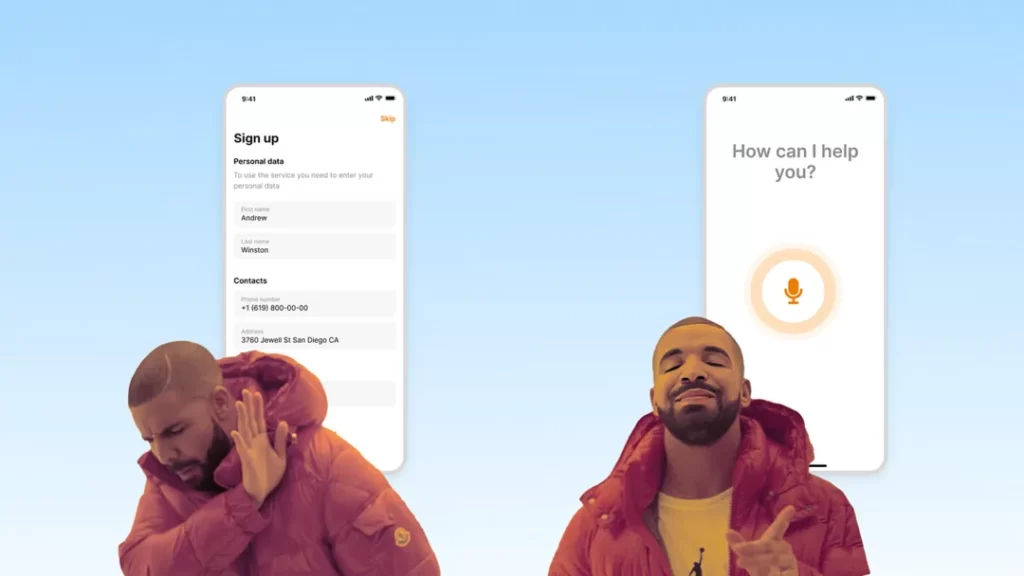
Beyond current design trends, breakthrough technologies promise to revolutionise mobile UX/UI in the decade ahead.
Holographic Displays
Holographic displays use light projection to generate 3D imagery observable from multiple angles.
Envisioning the Possibilities
Early applications could enable:
- Immersive social/gaming interactions
- Intuitive 3D product customisation
- Next-level digital commerce experiences
As the tech advances, glimpses of the metaverse future will emerge directly through our mobile screens.
Brain-Computer Interfaces
BCI devices translate neural signals into digital commands for controlling electronics.
The Road Ahead
In the mid-term, BCI could enable abilities like:
- Hands-free typing via imagined speech
- Environment control through concentration levels
- Accessibility support for neurodivergent and disabled users
Further out, seamless brain-app connectivity could feel telepathic.
e-Ink Flexible Displays
Displays constructed from electronic ink enable thin, bendable screens to mimic paper.
Key Benefits
Compared to rigid glass panels, advantages include:
- Thinner form factors – Compact integration into clothing, packaging, skin
- Shape morphing abilities – Wrapping around curved surfaces
- Reduced eye strain – Softer illumination, like print pages
As research and manufacturing scale, e-ink could lead to interfaces embedded anywhere imaginable.
Smart Lenses
Smart contact lenses with embedded electronics offer a discrete heads-up interface overlaying digital information onto natural-world environments.
Future Applications
Use cases in development include:
- AR navigation data
- Instant facial recognition
- Health/wellness monitoring
- Language Translation
Meanwhile, smart lens startups have already attracted over $1 billion in investments, anticipating the tech’s broad-scale commercialisation.
Key Takeaways
Despite exponential leaps in capabilities, mobile technology still feels like it’s only scratching the surface of its potential. As interfaces continue advancing, a few key points will remain constant:
Mobile-first design is mandatory – Optimising for smaller screens with touch constraints remains imperative as mobile usage outpaces other devices.
Convergence with ambient computing – Lines will blur between phones and interfaces embedded into environmental surfaces through spatial computing.
Human-centred principles endure – No matter how features evolve, catering experiences to human senses, context and emotions sustain engagement.
New modalities expand possibilities – Multisensory inputs like voice, AR, VR and BCI will reshape interactions beyond the limits of current interfaces.
By internalising these insights, designers and users can prepare for mobile revolutions. The easiest way to future-proof experiences is by honouring convenience, delight and humanity above all else.
Mobile Interface Design Trends FAQs
Here are answers to common questions about emerging mobile interface trends:
What is the most essential mobile UI design principle?
Crafting experiences purposefully tailored to address genuine user goals and pain points – rather than arbitrarily chasing innovation – sustains long-term engagement as features evolve.
Which emerging technology will most disrupt mobile interfaces?
Augmented reality promises the most transformative shift – overlaying digital enhancements onto natural environments unlocks revolutionary new product experiences and workflows once bound to screens.
When will we see widespread mobile holographic displays?
While select models showcase the tech today, analysts predict key challenges around projection brightness, battery drain, and manufacturing costs won’t be fully resolved until the 2030s before holographic mobiles hit mass market ubiquity.
